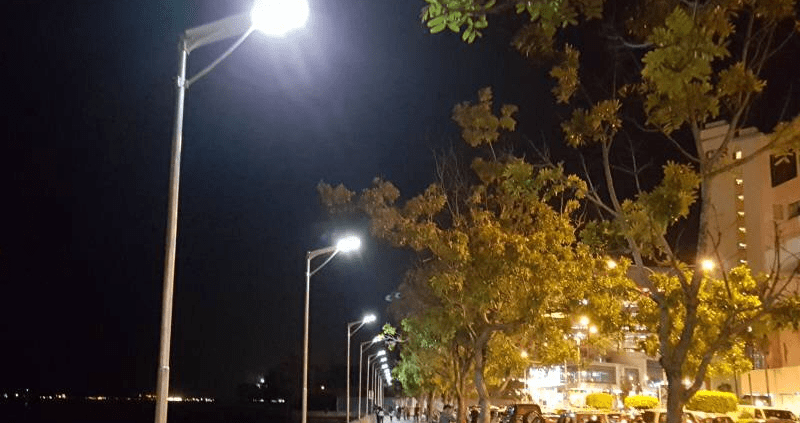How to Make a Solar Street Light Model?
There is an objective of every project and when we talk about solar street lights, the objective is to be a greener alternative to traditional street lights. In order to maximize the efficiency of a solar street light, each component needs to work at maximum energy utilization with minimal losses. Thinking about the solar street lights model might bring a lot of different designs and structures to your mind. While the basic design remains the same, it is only the aesthetics that are different in different variants of solar street lights. Let’s discuss how to make a simple model of solar street lights.
There are usually seven main parts that make a complete package of solar street light model:
- Solar Panel, also known as solar photovoltaic cell – used to convert sun energy to electric power
- Solar charge controller – used to control or regulate the flow of electric charge from PV module to the battery
- Pack of battery – used to store electric charge for use at night
- Street Lamp – a source of light
- Poles – for connectivity between different parts and installation on elevated surfaces
- Remote controller – to help control, manage and maintain the solar street light model
Depending on the manufacturer, the component type may vary.
Designing a solar street light model
First, calculate the amount of light required to illuminate the area. The bulb used will help you know the wattage. Use this wattage and the duration of illumination to calculate the watt-hours of the battery and any component that will be consuming the power. The wattage-hour will help you choose the PV module that is capable of producing that amount of energy. Do keep the energy losses in your mind and always choose a PV panel that is able to produce more energy than is needed to compensate losses. The angle and watt peak is dependent on the location of installation, so do a checkup about that.
To find out what size of the battery to use, the watt-hours needed for lights can help you in knowing that. Using some basic electrical formula, you can find out the depth of charge, nominal charge, and the capacity of the battery in amp-hours.
The size of the charge controller depends on the power requirement of the panel and your choice of energy storage. The basic rule is to use a charge controller that is capable of handling the current from the panel.
Assembling the Solar Panel
The solar panels are made of semiconductors; a substance that is able to conduct electricity under some conditions. The material usually used is silicon but there are other materials as well such as gallium arsenide, indium phosphide, and copper indium selenide. To make a solar cell, it needs trillions of silicon atoms in the form of a wafer layer. Each silicon atom contains extremely small and tiny things called electrons. These tiny electrons carry an electric charge. When sunlight hits the cells, the photons present in the sunlight will let the electrons loose from their atoms, and as the electrons flow through the cell, they produce electricity.
The solar panel is attached to the pole and with other components of the solar lighting system through cables. Brackets and frames are used to hold the solar panel. These brackets are usually made from aluminum to keep them lightweight and weather resistant.
Assembling the Battery
The battery assembly is done using the wires that permit it to connect with the PV module and with the LED lamp. The battery is designed efficiently to sustain continuous currents for longer periods of time. The battery assembly is usually kept inside an aluminum housing with open vents to keep the ventilation in order to dissipate heat produced by the batteries.
LED fixture
The LED fixture is attached to the pole through brackets and the height of the LED fixture is adjusted to have proper levels of lights. There are many designs of LED fixture available and is different for different variants of solar lights
Making the system more efficient
In order to optimize the whole system, there are certain components that need to be chosen carefully. The first thing is that instead of the fluorescent bulb, use LED lights to reduce energy consumption.
Use the best storage technology for the battery pack. In most cases, Li-Ion batteries are commonly recommended for use in solar systems. There are also some other technologies like Lead-acid, gel cell batteries, etc.
Use monocrystalline PV module as this is considered more efficient as compared to polycrystalline.
Minimize the energy losses in your system by choosing efficient wiring connections. The controller you use should be able to turn on and off the system efficiently.
Use of smart sensors
The solar lighting system can be equipped with the following smart controllers and a couple of sensors to increase its efficiency. A passive infrared sensor, which is used to detect motion and to control the levels of lighting. Using solar lights that have a motion sensor installed is an effective way to detect any activity outside of your home as it instantly shines a light on the person or object. There are other motion sensors as well such as microwave motion sensors, dual technology sensors, etc.
Battery Monitoring
This is helpful in order to prevent damages to the battery. When the battery senses an overcharge, it simply reduces the flow of energy and when a voltage drop happens due to a decrease in the intensity of the sunlight or because of an increase in sudden electrical usage, it allows to maintain proper voltage regulation.



